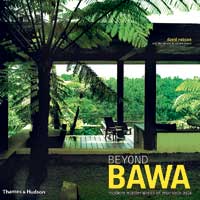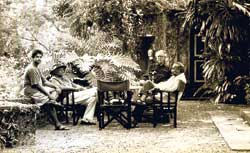
Beyond vernacular kitsch?On page 90 of his new book on the life, works and influence of Geoffrey Bawa, David Robson mischievously quotes Alexander Pope. Yet shall (my Lord) your just, your noble rules He is not, as it happens, referring to the way in which motifs and techniques invented by Geoffrey Bawa have been taken up, elaborated, distorted and ultimately reduced to cliché by an army of imitators. But he may as well be. Though Bawa passed away quietly in 2003, his spirit is still very much with us. When architects build those ‘typically Sri Lankan’ open-plan urban homes that ‘bring the outdoors in’, when they roof them with red tile laid over asbestos sheeting and burglar-proof them with concrete pergolas, they imitate Bawa, for these were his innovations. When merchants and lunching ladies fit out their modern homes with doors and windows stolen from old walawwas and decorate their verandas with hiramane, miris gal and araliya trees sprouting from concrete planters, they imitate Bawa, for these were his trademarks. Now, robbed of their meaning by indiscriminate adoption and made colourless by over-familiarity, they have become part of the vernacular architecture of Sri Lanka. It’s Bawa’s country now; the rest of us just live in it, and a damn’ poor job we’re making of it too.
The influence of Geoffrey Bawa on Sri Lankan architecture and middle-class aesthetics is vast: so vast, in fact, that we no longer notice it. Robson says his works ‘have changed the way we see or look at certain aspects or architectural designs in this country’. There is no disputing this; it has been an acknowledged fact ever since Madhura Prematilleke first exhorted Sri Lankan architects to ‘come out from under the umbrella’. But what about the rest of the world? What do they think, if they think at all, of Bawa? Was he a one-off, a sport, his work an architectural curiosity with nothing to contribute to the intellectual treasury of his profession or, more generally, of humankind? The purpose of Beyond Bawa is to prove, to Sri Lankans as much as anyone else, that Geoffrey Bawa was much more than that. It is an attempt to show how the ideas and innovations of this gifted, cosmopolitan Sri Lankan have inspired and influenced fellow-architects in countries as far away as London and Hong Kong. The focus, though, is on that part of the world immediately to the east of us – hence the book’s subtitle, ‘Modern Masterworks of Monsoon Asia’. Sri Lanka itself excepted, peninsular Asia is where, for Robson, Geoffrey Bawa’s influence – spread abroad by the famous ‘White Book’, by personal contacts with other architects and aesthetes and by a handful of overseas commissions – has made itself most palpably felt. In partial support of this argument, Robson cites the works of Ernesto Bedmar, Cheong Yew Kuan, Kerry Hill, William Lim, Peter Muller and others. To this reviewer, an architectural illiterate, he appears to make his case well. Others may disagree. Either way, it will make little difference to a typical reader of this book. It is for just such a ‘typical reader’ that this review is intended. So: how well does the book work as a book? Well enough, indeed; but there are some qualifications. Dip at random into the different sections of Beyond Bawa and you may well find yourself wondering whether they all belong in the same publication. Part One, ‘A Life in Architecture’, is most engaging. It deals with Geoffrey Bawa’s own life and works, including in the latter category not only his buildings but also his drawing techniques, exhibitions and Bawa-related publications. David Robson is clearly an admirer of Bawa and writes about him and his buildings with insight, erudition and sympathy. Much of the material here reprises that contained in his previous opus, Geoffrey Bawa: the Complete Works, which seems a pity when the present volume is so clearly intended (by the publishers, if by no-one else) as a companion to that book. However, the new book expands rather more on the subject of Bawa’s friends, associates and collaborators. In doing so, it reveals much about Geoffrey Bawa that the previous book did not. In place of the stiff, somewhat faded cut-out presented there, we get a rounded, credible and not always likeable rendition of the man, complete with faults and failings.
For this reader, the best pages of Part One and of the book as a whole are those dealing with Bawa’s architectural adventures in Bali during the mid-1970s. Robson argues that it was largely through his seminal effect on the now widely-recognized ‘Bali style’ that Bawa’s influence first spread beyond his native country. This came about by way of a collaboration between the architect and his brother Bevis’s close friend, the Australian artist Donald Friend, who had moved to Bali in 1966. In 1973, Friend invited Bawa out to the island to collaborate on various architectural projects financed by local and expatriate entrepreneurs, so opening the way for Bawa to develop an international reputation. The real delight of this chapter, as well as of an earlier one dealing with Friend’s sojourn in Sri Lanka, comes in the extensive use Robson makes of quotes from the artist’s diaries. It is no insult to Robson to say that the best writing in Beyond Bawa is by Donald Friend; the artist was clearly as accomplished a diarist as he was a painter and sculptor. Here is a pen-portrait of Bawa by Friend that captures the architect in a few deft lines: The grand ducal airs, the cultivated elegant voice and gestures, the sparkle of amused malice in his eyes. One envies him his (servants, his furniture, his) determined policy of self-aggrandisement.... There is plenty more good stuff where that came from.Part Two of the book combines two rather disparate groups, the artists and other creative folk who collaborated with Bawa to create an identifiable ‘Ceylon style’ in the Fifties and Sixties, and the architects who trained under and collaborated with him from the Seventies onward. Most of these former were the offspring of Colombo magnates and Kandyan landowners, young people of Westernized outlook who, somewhat self-consciously, sought inspiration in the indigenous motifs and cultural traditions their parents and grandparents had abandoned, following where the Eurasian aesthete Ananda Coomaraswamy had led a generation earlier. The most important of these collaborators were Ena de Silva and Laki Senanayake, and Robson gives them both their due. The other half of this section deals with the work of Sri Lankan architects closely associated with Bawa, such as C. Anjalendran and Channa Daswatte. Robson makes the connections and engagingly teases out the influences. This part of the book might be called the Inner Circle: it deals with those in close propinquity to Bawa, who were directly and personally influenced by him. It works well enough on that level, and Robson’s writing is still lively and interesting. In Part Three, however, it begins to flag. This is the part that deals with Bawa’s overseas inheritors. By now, the human interest and biographical detail that filled Part One and illuminated Part Two are nearly absent; Bawa’s architectural influence may linger, but the ghost has fled. The buildings presented (to judge from the supplied plans and photographs, as we are repeatedly warned throughout the book we must not) are interesting and often beautiful. A layman’s eye can see Bawa in many of them, though by no means all. Yet this section (the shortest in the book) is likely to appeal principally to students and connoisseurs of architecture. Well, you may ask, isn’t that the whole point? Who else could you expect to buy a book like this? Well, clearly the publishers, Thames & Hudson, expect a wider market than that; Beyond Bawa is lavishly, even extravagantly produced, and a two thousand or so copies sold to the cognoscenti are unlikely to cover the costs of publication. Whether or not the author intended it so this book will certainly find its way onto the coffee-tables of many folk whose only demands from architecture are that it should impress their business associates and keep the rain out. There is no reason why this should not be so, and so one is entitled to ask how the book will appeal to a general reader. This general reader’s impression is that it will do just fine. It is marvellously laid out, produced, printed and bound, a fine object in its own right. The layout deserves special mention, actually; the photo selection and page design are excellent, the typesetting and particularly the captioning impeccable. The featured buildings are well represented. As for the text, there is a real-life story (though one told better and in more detail in The Complete Works), several corollary stories, some insightful writing on Modernism, architectural fashion and philosophy, and plenty of beautiful buildings to read about as well as look at. No-one will complain of not getting their money’s worth. That the separate sections of the book lack cohesion, with the last sixty pages or so seeming at times like inserts from another book entirely, is no more than a bookworm’s quibble. But does David Robson prove his thesis to our satisfaction? It is impossible to deny that Bawa has had a visible influence on the architecture of ‘monsoon Asia’ – particularly in hotel design. Once Robson has helped us to recognize the elements of his style and the general thrust of his approach to architecture, it’s impossible to travel in Southeast Asia without seeing Bawa everywhere. The accepted ‘look’ for hotels and resorts in this part of the world, particularly upmarket ones, is derived from his work. Yet, with a few noble exceptions (such as those presented in this book), most of these overseas imitators of Bawa have done him no better justice than their Sri Lankan counterparts. They have created their own Bawafied version of what Kenneth Frampton, quoted in this book, dismissed as ‘kitsch vernacular’. Still, one cannot blame the original begetter for the errors of his ‘imitating-fools’. David Robson works hard to convince us that Geoffrey Bawa was not just a great architect but one of the greatest of the twentieth century; and while we cannot always pass as smoothly between the sections of his book as we do through the living spaces of a Bawa building, he succeeds admirably. |
|| Front
Page | News | Editorial | Columns | Sports | Plus | Financial
Times | International | Mirror | TV
Times | Funday
Times || |
| |
Reproduction of articles permitted when used without any alterations to contents and the source. |
© Copyright
2007 | Wijeya
Newspapers Ltd.Colombo. Sri Lanka. All Rights Reserved. |

